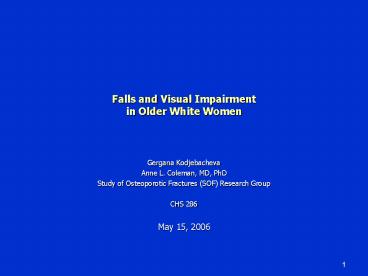Falls and Visual Impairment in Older White Women - PowerPoint PPT Presentation
1 / 21
Title:
Falls and Visual Impairment in Older White Women
Description:
CDC recommends annual eye exams to reduce the risk of falls ... 1997-1998: 4,820 women attended a clinic visit including an eye exam ... – PowerPoint PPT presentation
Number of Views:106
Avg rating:3.0/5.0
Title: Falls and Visual Impairment in Older White Women
1
Falls and Visual Impairment in Older White Women
- Gergana Kodjebacheva
- Anne L. Coleman, MD, PhD
- Study of Osteoporotic Fractures (SOF) Research
Group - CHS 286
- May 15, 2006
2
Presentation Overview
- Significance Falls as a major cause of increased
morbidity and mortality - Racial and gender disparities in falling
- Vision impairment as a predictor of falls
- Study of Osteoporotic Fractures association
between vision and falls - Implications Need for public health
interventions that reduce falls
3
Significance of Falls Major Health Concern
Among the Elderly
- Falls were the leading cause of injury death
(2003) - 30-50 of older adults experience falls each year
- 20-30 of older adults who fall suffer moderate
to severe injuries - Acute care costs of falls among older adults
(2003) 8 billion - White female gender doubles the risk of falls
Roudsari et al, 2005 Chang et al, 2004 CDC,
2003 Abdelhafiz and Austin, 2003 Legood et al,
2002.
4
CDC, 2003
5
Gender and Racial Disparities in Falling
CDC, 2003
6
Vision Impairment and Falls
- Cause of falls usually multi-factorial
- Visual impairment may compound or cause falls
- CDC recommends annual eye exams to reduce the
risk of falls - Higher level of awareness among older adults
needed
7
Geospatial Distribution of Elderly with Visual
Impairment
Visual impairment is a significant problem
among older adults.
8
Contrast Sensitivity
Surgical Eyes, 2006
9
Visual Acuity
Normal Visual Acuity
Low Visual Acuity
Mercer, 2006
10
Binocular Visual Field Loss
Peripheral visual field loss/ "tunnel vision
No Visual Field Loss
Central visual field loss
Central visual field loss and reduced visual
acuity
Scattered visual field loss
Mercer, 2006
11
Gaps in the Literature
- No AGS/CDC recommendations on what components of
vision should be assessed to best predict risk of
falls - Effect of visual acuity Conflicting study
results - Effect of contrast sensitivity Elevated risk
- Effect of visual field loss Limited and
inconclusive - Effect of binocular visual field loss No studies
12
Research Question
- What is a stronger risk factor for falls among
older white women - Contrast sensitivity?
- Visual acuity?
- Binocular visual field loss?
13
Methods
- Study of Osteoporotic Fractures (SOF)
prospective longitudinal cohort study - Four clinic centers Baltimore, Maryland
Minneapolis, Minnesota Portland, Oregon and the
Monongahela Valley, Pennsylvania - 1997-1998 4,820 women attended a clinic visit
including an eye exam - 4,071 (84) had reliable visual field tests in
both eyes and provided information regarding
frequent falling
14
Results Association between binocular visual
field loss (BVFL) and the risk of at least two
falls (N4,071)
Model 1 Unadjusted risk of at least two falls
for binocular visual field loss. Model 2
Adjusted for age and study site. Model 3
Adjusted for age, study site, contrast
sensitivity and visual acuity. Model 4 Adjusted
for age, study site, contrast sensitivity, visual
acuity and cognitive function.
15
Results Association Between Various Vision
Components and At Least Two Falls (N4,071)
16
Discussion Risk Factors for Falling
Results of Univariate Analysis of Most Common
Risk Factors for Falls in 16 Published Studies
AGS, 2001
17
Discussion Multifactorial Intervention
- Multifactorial interventions include (AGS, 2001
Gillespie Review, 2003) - Vision Correction
- Gait training
- Advice on the appropriate use of assistive
devices - Review and modification of medications
- Exercise programs
- Environmental hazards modification
- Treatment of cardiovascular disorders
Slide adopted from L. Moncada, MD
18
Limitations
- Lack of generalizeability to other demographic
groups - Highly motivated participants with relatively
good self-rated health status - Depth perception not studied
19
Conclusions
- Binocular visual field loss increases the risk of
falls in older white women. - The more severe the visual field loss, the
greater the risk of frequent falling. - The association was independent of other types of
visual impairment. - 30.6 of falls in women with severe BVFL is
attributable to visual field loss.
20
Public Health Implications
- Vision interventions might decrease fall-related
injuries and deaths - Association between vision intervention programs
and risk of falls a top research priority (AGS,
2001) - Assessment of risk is key to prevention
- Increased awareness of the association between
BVFL and falls is needed - Physicians and public health professionals can
play a major role in the reduction of falls
21
Thank you.Email smolian1_at_yahoo.com

